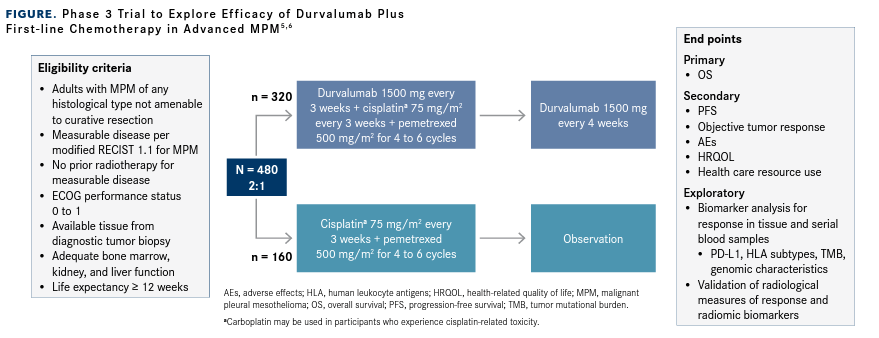Publication
Article
First-Line Durvalumab Aims to Add Additional Treatment Option in Malignant Pleural Mesothelioma
Author(s):
Investigators look to boost systemic therapy options for patients with malignant pleural mesothelioma with the phase 3 DREAM3R trial.
Patrick Forde, MBBCh

Investigators look to boost systemic therapy options for patients with malignant pleural mesothelioma with the phase 3 DREAM3R trial (NCT04334759). The study, which was initiated March 17, 2021, will further examine the safety and efficacy of durvalumab (Imfinzi) in combination with the standard chemotherapy regimen of cisplatin and pemetrexed (CP) in adult patients with MPM and attempt to fill the long unmet need for additional treatment options for this population.1
“When you block PDL-1, the idea is that the immune system can recognize foreignness within the tumor, particularly peptides and new antigens, [so that] it can then destroy the tumor cells,” explained Patrick Forde, MBBCh, director of the Thoracic Oncology Clinical Research Program and an associate professor of oncology at Johns Hopkins Medicine in Baltimore, Maryland, in an interview with OncologyLive®. “In other tumor types, including lung cancer, there has been shown to be synergy between chemotherapy and immunotherapy. Therefore, we believe that’s something [that] could potentially work well in mesothelioma as well.”
Initial Safety and Efficacy Data Spark Further Research
Patrick Forde, MBBCh The addition of durvalumab to CP was previously evaluated in the single-arm, phase 2 DREAM trial (ACTRN12616001170415). The trial enrolled 55 adult patients with MPM across 9 sites in Australia. Eligible patients were those with histologically confirmed MPM considered unsuitable for cancer-directed surgery, and measurable disease per modified RECIST 1.0 previously untreated with systemic therapy.2
Study participants received cisplatin 75 mg/m2, pemetrexed 500 mg/m2, and durvalumab 1125 mg intravenously on day 1 of a 3-week schedule for a maximum of 6 cycles. Treatment with durvalumab continued for up to 12 months, and safety analyses included all patients who received at least 1 dose of any study drug. The primary end point of the trial was progression-free survival (PFS) at 6 months.
Eligible patients (n = 54) were followed for a median of 28.2 months (interquartile range, 26.5-30.2) and the PFS at 6 months was 57% (95% CI, 44%-70%). The most common adverse events (AEs) of grade 3/4 were neutropenia (13%), nausea (11%), and anemia (7%). Five patients died during the study treatment, but none of these deaths was attributed to the treatment.
Investigators also evaluated the combination in patients with MPM in the single arm, phase 2 PrE0505 trial (NCT02899195). PrE0505 enrolled 55 patients across 15 sites in the United States. Patients with unresectable MPM, no prior therapies, and an ECOG performance status of 0 or 1 were eligible for the trial. Most patients had epithelioid histology (74.5%) and the median age was 68 years (range, 35-83).3
Patients were given durvalumab at a dose of 1120 mg plus pemetrexed 500 mg/ m2 and cisplatin 75 mg/m2 every 3 weeks for 6 cycles until disease stabilization or a response, then patients were given 1120 mg of durvalumab every 3 weeks until disease progression for a maximum of 1 year. The primary end point of the study was overall survival (OS). Secondary end points included PFS, safety, and objective response rate.
A Survey of the Treatment Landscape
Two systemic therapy options for MPM are approved by the FDA: CP and the immune checkpoint inhibitor (ICI) combination nivolumab (Opdivo) plus ipilimumab (Yervoy). The combination was approved on October 2, 2020, for the first-line treatment of adults with MPM that cannot be removed by surgery.4
“Chemotherapy was first shown to have a survival benefit for MPM [in 2003]—that was cisplatin and pemetrexed as first-line treatment for patients with newly diagnosed MPM,” Forde said. “The [median] survival in that study was 12.1 months, and that was approximately a 2- to 3-month improvement over cisplatin alone. Then for approximately 16 years, there were no advances, no new studies showing benefit. [In 2021], we saw the publication of the [results of the] phase 3 CheckMate743 study [NCT02899299]3, which was a global study that randomized patients to either cisplatin and pemetrexed or ipilimumab and nivolumab combination immune checkpoint therapy.”
Forde noted that the greatest survival benefit was observed in patients with nonepithelioid MPM, a histological subtype associated with poor prognosis.5 “There was a very marked benefit, improving survival from 8 months for patients with chemotherapy alone to 18 months with the [immune checkpoint combination],” he said. Specifically, the median overall survival among the 74 patients with nonepithelioid disease who received the combination was 18.1 months (95% CI, 12.2-22.8) vs 8.8 months (95% CI, 7.4-10.2) among the 75 patients treated with chemotherapy alone (HR, 0.46; 95% CI, 0.31-0.68). In the epithelioid group, the 229 patients treated with the ICI combination had a median OS of 18.7 months (95% CI, 16.9-22.0) compared with 16.5 months (95% CI, 14.9-20.5) for the 227 patients who received chemotherapy alone (HR, 0.86; 95% CI, 0.69-1.08).5
“We believe there’s still a role [for nivolumab plus ipilimumab] there for treatment innovations, particularly for those patients with epithelioid disease,” Forde said. “It’s great that we have a new option for patients with MPM [with] nivolumab and ipilimumab. However, it’s notable that the benefit [with that regimen] was predominantly in those patients with nonepithelioid disease, which [accounts for] approximately 20% to 25% of patients [with MPM]. Also, survival was quite similar between chemotherapy and combination immune checkpoint therapy for patients with epithelioid MPM.”
Investigators hypothesize that the DREAM3R trial may offer a benefit for all histologies of MPM.
Details of the DREAM3R Trial
DREAM3R is an open-label, randomized study that will enroll approximately 480 treatment-naïve patients with MPM in the United States, Australia, and New Zealand. Patients will be randomized 2:1 to receive durvalumab in addition to the standard treatment of CP or standard chemotherapy alone. Patients will be stratified by age (18-70 years vs older than 70 years), sex, histology (epithelioid vs nonepithelioid), and region (Australia/New Zealand vs United States).
Patients in the experimental arm will receive durvalumab at a dose of 1500 mg every 3 weeks, plus standard cisplatin 75 mg/m2 and pemetrexed 500 mg/m2 every 3 weeks for 4 to 6 cycles, followed by durvalumab 1500 mg every 4 weeks. Those in the control arm will receive standard chemotherapy alone at the same dose as the experimental group for 4 to 6 cycles followed by observation (Figure5,6).
Figure. Phase 3 Trial to Explore Efficacy of Durvalumab Plus First-line Chemotherapy in Advanced MPM5,6

Treatment will continue in the experimental arm until disease progression, unacceptable toxicity, or patient withdrawal. Tumor and quality-of-life assessments will be performed at baseline then at weeks 6, 12, 18, 26, 34, 42, and 50, followed by every 12 weeks until disease progression. A pretreatment tumor tissue sample will be required, and blood samples will be taken on day 1 of cycles 2 and 3.7
To be eligible for the study, patients be at least 18 years old with MPM of any histological type that is measurable by mRECIST 1.1. Eligible patients must have an ECOG performance status of 0 or 1; adequate bone marrow, kidney, and liver function; and a life expectancy of at least 12 weeks. Patients will be recruited over a period of 27 months and followed for another 24 months.
Patients will be excluded from the trial if they have any condition requiring systemic treatment with corticosteroids or other immunosuppressive agents. Patients who received a diagnosis based on cytology or fine needle aspiration only, contraindication for immune checkpoint inhibitors, or prior systemic anticancer therapy for MPM also will be ineligible.
The primary end point of the trial is overall survival. Secondary end points include progression-free survival, objective tumor response, and safety. Exploratory objectives will include the identification of biomarkers for response in tissue and serial blood samples, such as PD-L1 expression, human leukocyte antigen subtypes, tumor mutational burden, and validation of radiological measures of response and radiomic biomarkers. The estimated study completion date is December 2025.
“Particularly for patients with epithelioid histology, we see this [phase 3 trial] as having the potential to move the paradigm further,” Forde said. “If we can demonstrate a survival benefit from adding immunotherapy up front to chemotherapy, both of which are potentially effective therapies, especially for epithelioid disease, we could have a new option in the first-line setting. That’s something we’re hopeful to find from DREAM3R and from other ongoing studies.”










